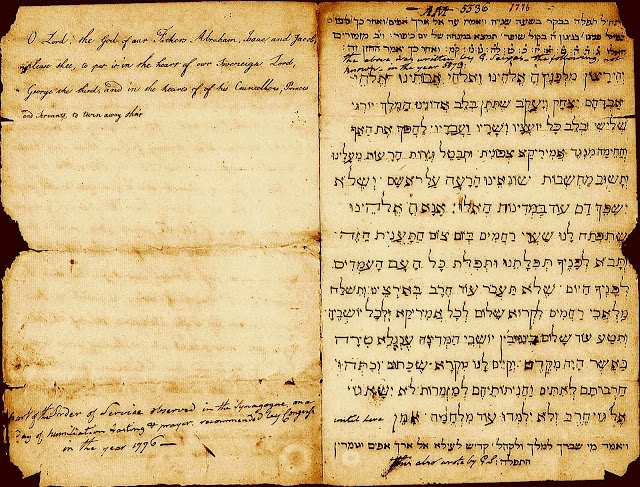1. Here we've got a prayer composed for New York Governor George Clinton and אדוננו General דשארדש וואשנגטן in 1784.
It mentions God's 13 attributes of mercy, the 13 principles of faith, and the 13 colonies of America. And as you can see, it links the freedom of the 13 colonies with the freedom that will come from the redemption of the Messiah.
This prayer was already translated in 1920, here, so click the link if you'd like to see the translation. Just to point out something interesting, notice that the name Samson (two lines above GEORGE WASHINGTON) is vocalized in Hebrew as "Shamshon," perhaps reflecting the
On the back of this document, written in a very old hand, is named the composer of the prayer, the mysterious "Rabbi Hendla-Ieochanan Van Oettingen," and Jacob Cohen, who was acting chazan at Shearith Israel in New York, and presumably chanted it.
(Source: Jacques Judah Lyons papers; P-15; 1; 64; American Jewish Historical Society, New York, NY, and Boston, MA.)
2. This one is perhaps even more interesting. Then, as now, war was looked upon by many as a great evil, especially between brothers, and many American Colonists only wanted the oppressive measures of King George III to be lifted, bloodshed ended, and peace restored. The nascent American Congress called for a day of "Humiliation, Fasting and Prayer" along these lines for May 17, 1776. It was for this occasion that this prayer was recited in Congregation Shearith Israel in New York.
As you can see, a complete service was arranged for this occasion, meant to invoke the solemnity and seriousness of the occasion; after morning prayer, Tachnun was to be sung to the tune of a Yom Kippur pizmon; a dozen Psalms recited, and then the Hazan would recite this prayer written for the occasion, and of course all were to be fasting. The prayer hopes for a change of heart for King George III and his advisors, that they would rescind their wrath and harsh decrees against "North America," that the bloodshed should end, and peace and reconciliation should obtain between the Americans and Great Britain once more, in fulfillment of the Messianic verse that Nation shall not lift up sword against nation.
Of course this was not meant to be, and six weeks later the American Congress declared independence from Great Britain, and there was no walking back from the hostilities which had already occurred.
(Source: Jacques Judah Lyons papers; P-15; 1; 4; 234; American Jewish Historical Society, New York, NY, and Boston, MA.)









You don't answer your email :((((
ReplyDeleteInteresting, Fred. Ladino spelling wasn't really standardized, but I believe the gee-as-in-"George" sound was usually rendered as a gimmel with a geresh, and I sort of expected that Shearith Israel would have used a Ladino-based translit. Shows how much I don't know.
ReplyDeleteActually, Mike, the Shearith Israel members would not have used Ladino, an archaic form of Spanish preserved by Jews who took refuge in the Ottoman Empire. Those who stayed in Spain or Portugal as crypto-Jews and only later made their way to Holland, England, or America would have spoken a more modern "standard" Spanish or Portuguese. So the question of the expected Ladino spelling is moot, though I do wonder when and where the gimmel-geresh convention originated.
ReplyDeleteThank you, Dan.
ReplyDeleteIs it just my computer, ot are there words missing at the end of this? - "Just to point out something interesting, notice that the name Samson...is vocalized in Hebrew as "Shamshon," perhaps reflecting the "
ReplyDeleteNot just you. I suspect that it's a typo, although likely a reference to another post on the pronunciation of R' Hirsch's name.
ReplyDeleteSorry, I lost my train of thought in middle. I was going to say something about this being evidence of a traditional pronunciation of the name. In all likelihood, or at least it's possible, people were so accustomed to this pronunciation that many did not realize that it is not actually vocalized with a patach, but with a chirik. I would give as a parallel the name Nachum, commonly pronounced "Nochum" in certain circles. Dollars to donuts that most people who use this pronunciation do not realize that in the Bible it is "Nachum," with a patach. And yes, related to R. Hirsch's name. The author of this prayer was probably of Dutch origin.
ReplyDeletehttp://www.haaretz.com/news/features/this-day-in-jewish-history/.premium-1.657200?utm_source=dlvr.it&utm_medium=twitter
ReplyDeleteThe “On the Main Line” blog some years ago, in a column on Hildesheimer, quoted one of his daughters, Esther Calvary, who recalled how on holidays, between the afternoon and evening prayers, her father would gather the children about him and sing German lieder: “And each time for us, his children, the high point was when he sang his favorite, Heine’s ‘Die Zwei Grenadiere.
’”http://onthemainline.blogspot.co.il/2005/05/r-shach-on-r-azriel-and-what-it-means.html
Fred, I was going to say something about "Nochem," but it got too unwieldy, so I posted about it instead. http://considerthesource2.blogspot.com/2015/05/nahum-and-nokhem.html
ReplyDeleteThis is not "in certain circles". The prophet was Nachum, but in the Mishna there are several men by this name, and it is always Nochum with a komatz.
ReplyDeleteBy looking at the vocalised manuscripts of Mishnayos. There are several Nochums, and no Nachums.
ReplyDeleteUm, which vocalized manuscripts postdate Yiddish? Or come from any area where Yiddish was spoken?
ReplyDeleteI'm not sure what your point about the Targum is. Surely the Targum is just more evidence that in the Tana'ic era the name was universally pronounced that way.
digital.library.mcgill.ca/fishstein/images/12_07 Star Spangled Banner.jpg
ReplyDeleteJust found this Yiddish star spangled banner, via Wikipedia, and thought the oilam would find it of interest.
http://digital.library.mcgill.ca/fishstein/images/12_07%20Star%20Spangled%20Banner.jpg
ReplyDelete